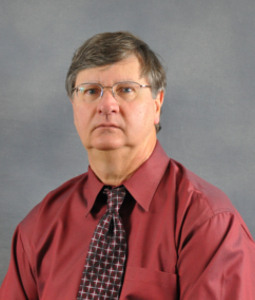Department of Chemistry and Biochemistry
Students, Researchers and Emeritus
S. Michael Angel
| Title: | Carolina Trustee Emeritus / Fred M. Weissman Palmetto Chair in Chemical Ecology Analytical / Physical and Planetary Spectroscopy |
| Department: | Chemistry and Biochemistry Department of Chemistry and Biochemistry |
| Email: | smangel0@mailbox.sc.edu |
| Resources: | CV [pdf] All Publications Department of Chemistry and Biochemistry |

Education
B.S., 1979, North Carolina State University
Ph.D., 1984, North Carolina State University
Honors and Awards
Governor's Award for Scientific Research, 2022; SAS Lester W. Strock Award, 2019; SAS William F. Megger's Award, 2018; Elected Fellow of Society of Applied Spectroscopy (SAS), 2015; Michael J. Mungo Graduate Teaching Award, 2015; Southern Chemist Award, 2015; Mars 2020 SuperCam Team Member, 2014; Carolina Trustee Professor Award, 2013; Applied Spectroscopy William F. Meggers Award, 2012; ACS South Carolina Chemist of the Year Award, 2012; Federation of Analytical Chemistry & Spectroscopy Societies (FACSS) Innovation Technology Award, 2011; USC Mortar Board Excellence in Teaching Award, 2011; Fellow of the American Association for the Advancement of Science, 2011; USC Educational Foundation Research Award for Science, Mathematics and Engineering, 2009; Lawrence Livermore National Laboratory, Physics and Advanced Technologies Directorate Award, 2006.
Research Interests
Development of in situ and remote characterization techniques based on remote spectroscopy including Raman, LIBS and REMPI. Of particular interest is applying optical spectroscopy to remote measurements in extreme environments and development of fieldable spectroscopic instrumentation for oceanic and planetary exploration.
We are exploring a number of in-situ and remote spectroscopic techniques for environmental, marine, earth and space science. In past research, microimaging sensors were used for in-situ measurements of analyte diffusion in thin membranes and in other work resonance enhanced multiphoton laser ionization, REMPI, was used to measure ppb levels of toxic compounds in soil samples. In more recent work, laser-induced breakdown spectroscopy, LIBS, is used for remote, noncontact elemental analysis and is being applied to in-situ chemical measurements in the deep ocean (see image gallery) and is also being considered for a Venus lander instrument. Other techniques being explored include standoff Raman spectroscopy and Raman imaging for planetary and homeland security applications.
Recently our focus has been on deep-ocean applications of LIBS, and standoff Raman spectroscopy for measuring hazardous materials and for planetary applications. LIBS is difficult in bulk aqueous solution because the laser-induced plasma is rapidly quenched by water. The quenching problem can be overcome by using very short detector gate delays and by the use of laser pulse pairs, where a water bubble created by the first laser pulse isolates the LIBS plasma that is formed by the second laser pulse and trapped in the bubble. It is hoped that this technique will allow LIBS to be used for elemental analysis of hydrothermal vent fluids at 2–3 km depths.
Standoff Raman is being explored for homeland defense applications including detection of high explosive materials at many 10s of meters distance, and for applications related to planetary exploration. Our recent investigations of standoff Raman spectroscopy for planetary applications has led to the development of a new type of Fourier transform Raman spectrometer, the spatial heterodyne Raman spectrometer (SHRS), that will lead to extremely small, robust Raman instruments suitable for planetary lander missions. A miniature UV SHRS could be small enough to use in a CubeSat lander (10x10x10cm) of the type currently being considered by NASA for use in exploring the icy moons of Jupiter and Saturn and the asteroids. A SHRS system currently in use in our lab uses 2.5 mm diffraction gratings, with an interferometer footprint that could be as small as 5x5mm, and has very high light throughout allowing a cell phone to be used as the detector (see image gallery). Miniature Raman spectrometers are also useful for in-situ sensing and process control applications.
Selected Publications
“Standoff LIBS using a Miniature Wide Field of View Spatial Heterodyne Spectrometer
with Sub-Microsteradian Collection Optics,” Patrick D. Barnett, N. Lamsal, S. M. Angel.
Appl. Spectrosc. LIBS Special Issue, 71, 583-590 (2017).
DOI: 10.1177/0003702816687569.
“Miniature Spatial Heterodyne Raman Spectrometer with a Cell Phone Camera Detector,” Patrick D. Barnett and S. Michael Angel, Appl Spectrosc. 2016 Aug 29, DOI: 10.1177/0003702816665127.
“Ultraviolet Stand-off Raman Measurements Using a Gated Spatial Heterodyne Raman Spectrometer,” N. Lamsal, S. K. Sharma, T. E. Acosta, S. M. Angel. Appl. Spectrosc. 2016. 70(4): 666-675 DOI: 10.1177/0003702816631304.
“Performance Assessment of a Plate Beam Splitter for Deep-UV Raman Measurements with a Spatial Heterodyne Raman Spectrometer,” Nirmal Lamsal and S. M. Angel, Appl. Spectrosc. 2016. DOI: 10.1177/0003702816678869.
“Transmission Raman Measurements using a Spatial Heterodyne Raman Spectrometer (SHRS),” K. A. Strange, K. C. Paul, S. M. Angel. Appl. Spectrosc., In Press 2016. DOI: 10.1177/0003702816654156.